 Relevancy and Engagement
agclassroom.org/sc/
Relevancy and Engagement
agclassroom.org/sc/
Lesson Plan
Understanding Bacteria (Grades 6-8)
Grade Level
Purpose
This lesson introduces students to food safety, the 4 Cs of Food Safety, the Farm-to-Table Continuum, who’s responsible for keeping our food safe, and the link between food safety and other content areas. Students will also be challenged to hypothesize about where most bacteria are found and develop awareness that bacteria are everywhere and that various surfaces might have different levels of organisms. Grades 6-8
Estimated Time
Materials Needed
Activity 1:
- A hamburger, glass of orange juice, and a salad
- Option: Use pictures or food models.
- Hot plate and skillet
- Food Safety Farm-to-Table Continuum illustration
- Dr. X and the Quest for Food Safety video Module 1 — Understanding Bacteria (First 15 minutes of video)
Activity 2:
For the class:
- Dissecting microscope or hand lens to view microbial colonies
- Additional sterile Petri dishes with nutrient agar and covers for expanded tests
- Disinfecting solution to disinfect lab surfaces (20 ml of liquid household bleach in 1 L of tap water, see Safety First in the Lab handout)
For each team:
- 3 sterile Petri dishes with nutrient agar and covers
- 2 cups of sterile water
- Parafilm to seal the dishes
- Permanent marker
- Safety gloves
- Safety goggles
- Lab Report Outline for each student
- Bacteria Everywhere Data Table to record results
Advance preparation:
- Prepare or order 3 sterile Petri dishes containing nutrient agar for each team of 3 to 4 students. You may want to order extra dishes for students to test additional areas. Note: Petrifilm™ dishes can be used instead of Petri dishes. See Resources on page 95.
- Sterilize (boil) 500 ml of tap water for each team. You can boil the water in beakers and then cover with aluminum foil until ready to use. Students will use the water to wet swabs for testing dry surfaces.
- Make one copy of the Lab Report Outline for each student.
- Make one copy of the Bacteria Everywhere Data Table for each team.
Vocabulary
bacteria: a group of single-celled living things that cannot be seen without a microscope that reproduce rapidly and sometimes cause diseases
deoxyribonucleic acid (DNA): deoxyribonucleic acid; a self-replicating material present in nearly all living organisms as the main constituent of chromosomes; the carrier of genetic information
foodborne illness: any illness resulting from the consumption of food contaminated with viruses, parasites, or pathogenic bacteria
Did You Know?
- 1 million bacteria can fit inside 1 square inch.
- Bacteria can multiply quickly- in fact, one cell can double within 20-30 minutes.
- It takes less than 10 E. coli bacteria to make you sick.
Background Agricultural Connections
Food safety is everyone’s responsibility — everyone involved in growing, processing, transporting, and handling our food along all the points in our complex food production and distribution system. This responsibility includes all of us as we purchase, prepare, and eat our food. Students need to understand that food safety is a very serious issue that affects the well-being of every individual. So, because everyone must eat, we’re all at risk of becoming ill if food becomes contaminated.
Food Safety and the Battle with Bacteria
The United States has one of the safest food supplies in the world, but there’s always room for improvement. The battle to prevent foodborne illness is waged every day because bacteria are everywhere. Food safety has to do with controlling bacteria. And since everyone eats, we all share the responsibility for keeping our food free from harmful bacteria.
Electron Microscope
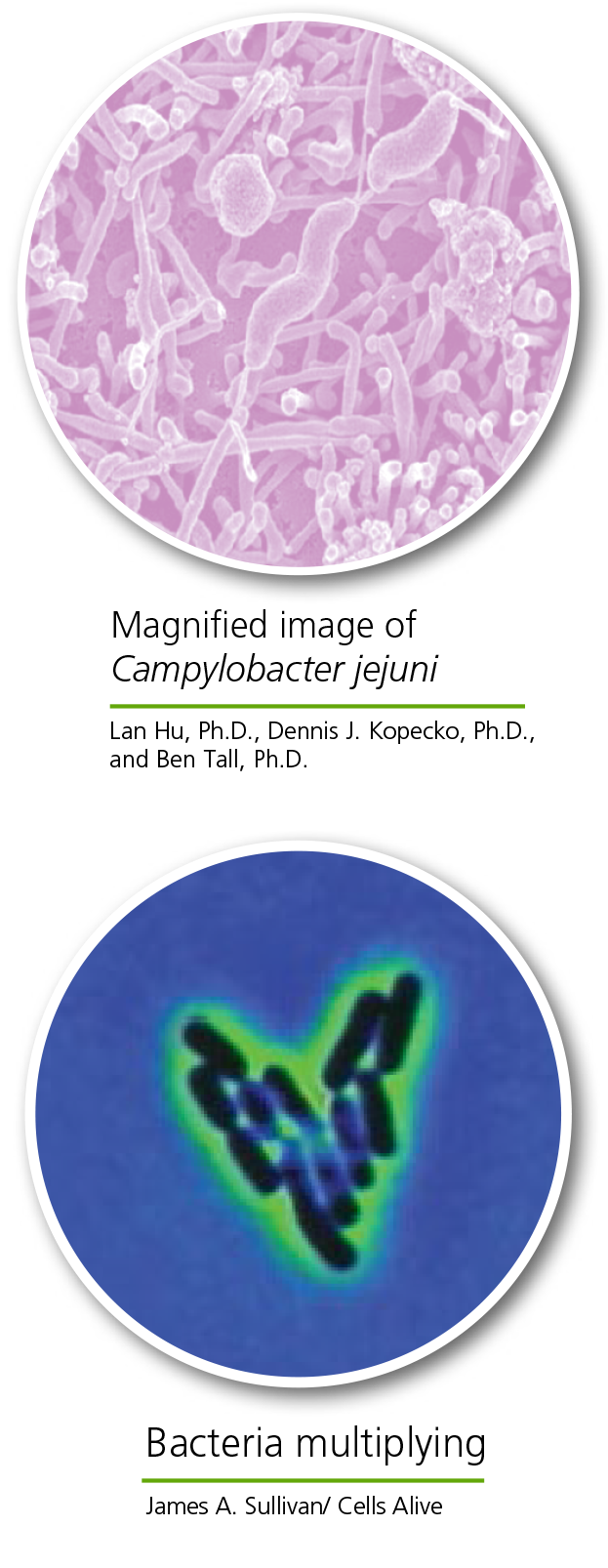
An electron microscope uses electrons instead of visible light to produce magnified images. It can magnify bacteria a million times their normal size.
Where Bacteria Come From and How They Grow
Bacteria are found everywhere, and under the right conditions, they can multiply fast! Each bacterium contains all the genetic information needed to make copies of itself. Bacteria multiply through binary fission, a process in which the cell’s DNA doubles, the cell splits, and two independent cells are formed. Under the right conditions, a single bacterium will double with each division — 2 become 4, 4 become 8, etc. A single cell can turn into millions of cells in a few hours and billions of cells within one day!
This rapid growth is not usually a problem with good bacteria; however, when it occurs with “bad” bacteria (a.k.a. pathogens), it is “bad” news. As pathogens multiply, some give off harmful toxins or become infectious. If pathogens get into our food and multiply, people can get sick.
The 12 Most Unwanted Bacteria
- Campylobacter jejuni
- Clostridium botulinum
- Clostridium perfringens
- Escherichia coli O157:H7
- Listeria monocytogenes
- Salmonella Enteritidis
- Salmonella Typhimurium
- Shigella
- Staphylococcus aureus
- Vibrio cholerae
- Vibrio vulnificus
- Yersinia enterocolitica
Required Conditions for Bacterial Growth
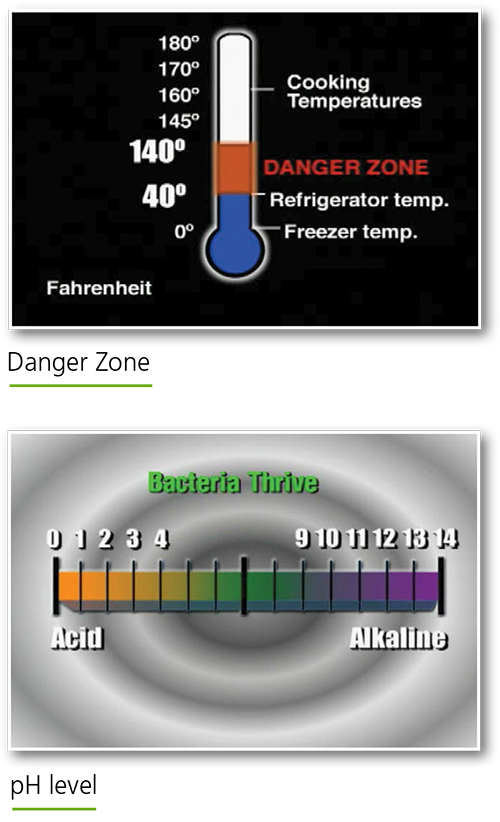 Time/Temperature — Under the right conditions, some bacteria can double their numbers within minutes and form toxins that cause illness within hours. To minimize bacterial growth in foods, it’s important to keep food temperatures below 40° F (4° C) or above 140° F (60° C). The level in between this temperature range is known as the Danger Zone.
Time/Temperature — Under the right conditions, some bacteria can double their numbers within minutes and form toxins that cause illness within hours. To minimize bacterial growth in foods, it’s important to keep food temperatures below 40° F (4° C) or above 140° F (60° C). The level in between this temperature range is known as the Danger Zone.- Nutrients — Bacteria need many of the same nutrients as humans in order to thrive (glucose, amino acids, and some vitamins and minerals). For example, bacteria grow rapidly in high-protein foods such as meat, poultry, eggs, dairy, and seafood.
- pH — Microorganisms thrive in a pH range above 4.6. That’s why acidic foods like vinegar and citrus juices are not favorable foods for pathogenic bacteria to grow; however, they may survive in these foods.
- Moisture — Most bacteria thrive in moist environments; they don’t grow on dry foods. That’s why dry foods like cereals can safely sit out at room temperature.
- Note: If dry foods like dry cereals or spices become contaminated from infected hands or equipment, bacteria can survive on the food and make people sick, but they can’t grow or multiply until the food is consumed.
How the 4 Cs of Food Safety Control Bacteria
If bacteria can grow so rapidly under the right conditions, then how do we control them? It’s simple:
- Cleaning — removes bacteria from hands and surfaces.
- Cooking — kills bacteria by breaking down their cell walls and destroying enzymes, which they need to survive.
- Chilling — slows down the bacteria’s metabolism, thus slowing their growth.
- Combating Cross-Contamination (separating foods) — prevents bacteria from spreading from one food item to another, or between foods and hands or surfaces/utensils.

Emerging Pathogens
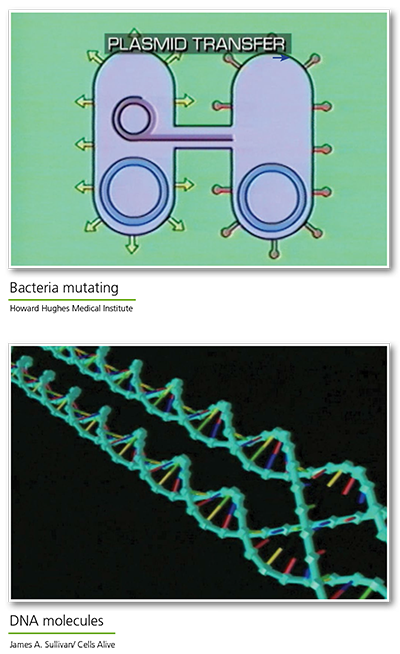
Not only can bacteria multiply quickly, but they can also mutate (adapt and evolve), a process that results in changes to their genetic code. These changes happen very slowly and can make the bacteria better able to survive. These changes can also change harmless bacteria into harmful bacteria, which often possess a new genetic characteristic like antibiotic resistance.
How Scientists Can Tell Good Bacteria from Harmful Bacteria
DNA (deoxyribonucleic acid) is the “genetic blueprint” for all living things. A DNA molecule looks like a double helix that’s shaped like a long ladder twisted into a spiral. The ends are joined to form a continuous loop, like a rubber band.
DNA contains the information that gives living organisms their traits or characteristics. In people, it determines traits like physical features, behaviors, and even whether we’re right or left-handed. In bacteria, the DNA molecule encodes the information that enables bacteria to grow, reproduce, and cause illness.
Scientists use DNA “fingerprinting” to identify similar groups of bacteria. DNA is treated so that it exhibits its own special pattern. When there is an outbreak of foodborne illness, epidemiologists (scientists who track down the causes of diseases and find ways to control them) try to determine the source of bacteria in foods by examining the pathogen’s DNA “fingerprint.” Then they see if it matches up to “fingerprints” (patterns) from other samples.
Food Safety Connection
Food safety is everyone’s responsibility — everyone involved in growing, processing, transporting, and handling our food along all the points in our complex food production and distribution system. This responsibility includes all of us as we purchase, prepare, and eat our food. Students need to understand that food safety is a very serious issue that affects the well-being of every individual. So, because everyone must eat, we’re all at risk of becoming ill if food becomes contaminated.
Science and our Food Supply Modules
This lesson was developed as a portion of an entire unit of lessons focusing on food safety from farm to table. Use the following links to see the remaining lessons:
Module 1: Bacteria
- Understanding Bacteria
- The 12 Most Unwanted Bacteria
Module 2: Farm
Module 3: Processing and Transportation
Module 4: Retail and Home
- Supermarket Smarts
- Cooking Right: The Science of Cooking a Hamburger
- A Chilling Investigation
- Crossed Up!
- Hands Off, Bacteria!
Module 5: Outbreak and Future Technology
Evaluation
Engage
- As students walk in, be cooking a hamburger to entice their senses. Other options are to post a large picture of the food in a conspicuous place, use food models, or dress up as a waiter/waitress. You can wear an apron and have a pad and a pen readily available for taking your students’ “orders.” As the students come in, let them comment on the food. Don’t give them an explanation. Let the atmosphere stimulate their curiosity.
- Walk up to one student and ask, "May I take your order, please? How do you like your hamburger? What would you like on your salad?"
- Take 2 or 3 more orders and write them down. Then ask students (if they haven’t already asked you), "What do you think the hamburger, orange juice, and salad have to do with science?"
- List their answers on the board, then ask, "Which of these foods would you most like to eat? Is there anything that might be on the hamburger, in the orange juice, or in the salad that you didn’t order?"
- You may have to give them a few hints. Hopefully, someone will mention bacteria or germs. Then say, "Aha! You have your first clue to the connection between these foods and science!"
- Now ask, "Have you or has anyone you know ever become ill from eating food?" Encourage students to explain when? what? and where? How could you get sick from a hamburger, orange juice, or a salad? (You can get sick if harmful bacteria are present in the food. This is called “foodborne illness,” sometimes referred to as “food poisoning.”)
Explore and Explain
Activity 1: The Big Picture
- Use the following exercise to emphasize how prevalent foodborne illness is and to help students realize the seriousness of this issue and how it relates to them. Ask students, "How many of you have been affected by foodborne illness?" Write that number on the board.
- Now compute the percentage of the class who think they’ve had foodborne illness.
- Using that percentage, ask the class to estimate the number of students in the entire school who might have had foodborne illness.
- Note: Tell the students that this is only an assumption, and not an actual survey. This information is simply being discussed to help the students relate to the statistics that you are about to give them.
- Present this information on the board:
- Foodborne Illness in the U.S. (2010 estimates):
- 48 million illnesses
- 128,000 hospitalizations
- 3,000 deaths
- Centers for Disease Control and Prevention
- As of February 2014, there were approximately 317.5 million people in America. [For the latest U.S. population count refer to the U.S. Census Bureau population clock] Ask the students to calculate the percent of the U.S. population that would be affected if 48 million people were to become sick due to foodborne illness. Discuss the students’ reactions to this percentage and have them relate it to the percentage calculated for the class. Then, reiterate the importance of studying food safety to prevent foodborne illness.
- Foodborne Illness in the U.S. (2010 estimates):
- Let the students form the following 3 teams — hamburger, orange juice, and salad. Then ask, "How do you think the hamburger, orange juice, or salad got to you?" Let them brainstorm for about 10 minutes and have them list their ideas. This exercise provides the segue for introducing the Farm-to-Table Continuum.
- Show students the Food Safety Farm-to-Table Continuum illustration. Let them cross-check their lists with the Continuum. Tell them that they may include even more steps, and that’s good!
- Now ask, "Whose responsibility is it to keep this hamburger, orange juice, and salad safe from harmful bacteria?" Hopefully, the students will come to the conclusion that it’s everyone’s responsibility, including their own once the food is in their possession. Discuss the reasons we all play a role in protecting our food supply.
- Next you will show a short video clip. Introduce the video by explaining: "There’s a lot of science behind keeping our food safe. Throughout this lesson, you’ll become food scientists and conduct labs and research projects. Let’s begin by meeting Dr. X, a crusading food scientist who has dedicated his life to fighting harmful bacteria and foodborne illness; and Tracy, a student who is working on her science video project and teams up with him on his mission. I challenge you to uncover the following food safety/science links as you watch the video."
- What 4 weapons does Dr. X use to fight harmful bacteria?
- What is the significance of the mysterious O157:H7?
- What is Dr. X referring to when he talks about the “baddest of the bad”?
- What does DNA have to do with bacteria? What does it tell us?
- Tell the students: You’ll be conducting labs and doing further research on many of the things you’ll see in the video, so pay close attention!
- Show video Module 1 — Dr. X and the Quest for Food Safety (Time: 15 minutes).
Activity 2: Bacteria Everywhere
- As students walk into the classroom, be peering through a large magnifying glass in search of bacteria in various sections of the classroom. Your students will wonder what you’re doing. Explain to them, "You’re going on a microorganism safari, and during this safari you’re going to become “science detectives.” Your assignment is to find areas where bacteria are living and come up with a plan to determine which areas have the most and least bacteria."
- Get the students started by asking, "Are there bacteria in this classroom? Where? Where else might they be living around the school?" Make a list of the responses. Some probable answers include soda machines, door knobs, desks, trash cans, door handles, water fountains, faucet handles, bathroom stall doors, toilet seats and flush handle, biofilm in sink drains, paper towel dispenser handle, lab tables and counters. Allow the students to mention things at home, but tell them, "For today, let’s investigate bacteria here at school." If they haven’t mentioned their hands, under fingernails, etc., ask, "What about you? Could bacteria be on you?" Now ask, "What do bacteria look like? (Let them discuss this.) Can you see them? If you can’t see them, how can you tell that bacteria really exist? This leads us into today’s lab. We’re going to design labs that allow us to 'see' bacteria."
- Have students work in teams of 3 to 4. Ask each team to select a team name, and then choose at least 4 to 6 areas of the classroom/school to examine. Have the students try for as many different areas as possible, but make sure the important areas, such as hands and/or under the fingernails, are tested by at least 2 teams. (If students are searching for bacteria on their hands or under their fingernails, they should wash their hands after they swab those areas.)
- Now, have each team hypothesize about which areas will have the most bacteria. Which will have the least bacteria? Why? How fast will the bacteria grow? Why?
- Have each team design a lab to test its hypothesis.
- Let each team present its hypothesis and lab design to the class. Encourage students to discuss the merits of each suggested test. This is also an important time for “guided inquiry.” For example, you can guide them by asking a question such as: How can you be sure that your agar isn’t contaminated? (You should always have a control dish). After the group discussions, give teams time to revise their hypotheses and lab designs.
- Show students how to swab a surface (on dry surfaces use a moist swab) and inoculate a Petri dish (see second page of the attached Safety First in the Lab handout). These procedures will be used throughout the unit.
- Review the important rules of lab safety, especially the handling of bacteria in Petri dishes (see page 1 of the Safety First in the Lab handout).
- Give each team 3 Petri dishes. Ask them, "Is there anything you should do with these dishes before you start your lab?" Have the students:
- Label the dishes on the bottom (agar side).
- Divide the control dish into thirds. Label the control dish: agar, wet swab, and dry swab. Then, swab the control dish.
- Divide and label the other 2 dishes with the areas they want to test.
- Label the dishes with the date, their team name, class, and hour to avoid mix-ups. Remind them to label along the side, so that they’ll be able to see the bacterial growth in the center.
- For easy and fun identification, students can swab the dishes using their initials.
- Give the students 10 to 15 minutes to gather their samples and inoculate their dishes.
- Seal Petri dishes closed with Parafilm.
- Place dishes in an incubator at 35° C (95° F) or let the dishes sit at room temperature for the appropriate amount of time.
- Ask students to set up time parameters — the number of hours or days they think it will take for the bacteria to grow.

- Have students observe the bacterial growth and record the results. Students can use the Bacteria Everywhere Data Table to record their results.
- Tip: Ask the students to draw their Petri dishes on the back of the Data Table and illustrate the colonies that are growing.
- Students can analyze the results based on their observations. Ask them:
- "What do you see?" (Their first observation may be the number of bacterial colonies. If so, use a 0–5 scale for rating the quantity. Guide students in ranking the results.)
- "What else do you notice about the colonies?" (Their next observation may be the size and shape of the colonies.)
- "Why do they look different?" (Different colonies/ microorganisms have different characteristics.)
- Have each team report the following to the class: the areas they sampled, the number of colonies they observed, and the characteristics (size, shape, and color) of the colonies.
- Ask students, "Were there any differences in your results compared to the other teams? How did your results support or reject your hypothesis?"
- "Are the colonies composed of good or harmful organisms?" (With this lab, students will not be able to identify good versus harmful organisms — they would need specific agars to grow and identify specific organisms. The purpose of the lab is to demonstrate that bacteria are everywhere and different surfaces have different levels of organisms. Also, stress that not all bacteria are harmful. In fact, most bacteria are beneficial to us.)
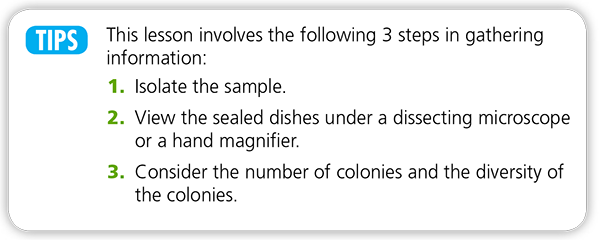
- Be sure to properly dispose of the Petri dishes as outlined in the Safety First in the Lab handout.
- Ask students to write a lab report (see the Lab Report Outline).
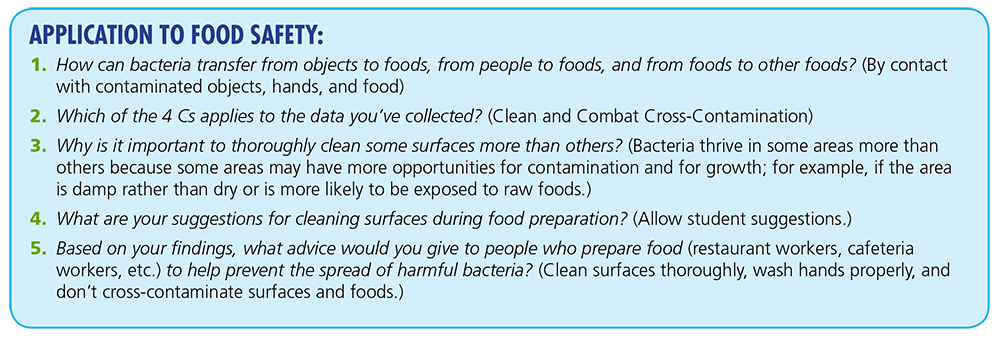
Elaborate
-
Check out the Food Safety A to Z Reference Guide, particularly the 4 Cs section beginning on page 52.
-
Collect articles on food safety from your local paper and TV news reports, and write a report on local food safety issues. Post articles and reports on the class bulletin board or class web page.
-
Survey people in your class/grade/school/faculty to find out how many of them may have experienced foodborne illness.
-
Research the following questions:
- Is it possible to eradicate all bacteria from the environment? Why or why not?
- Would this be a good idea? Why or why not?
- What essential functions do bacteria play in the environment?
-
Bacterial Reduction Activity:
- Write a hypothesis and design a lab to remove or reduce the amount of bacteria on the areas where you saw bacterial growth. Test variables such as:
- Different techniques, e.g., rinsing hands with water versus washing with soap and water, versus not washing at all.
- Washing hands for different lengths of time: 10 seconds, 15 seconds, 20 seconds.
- Other variables that you might suggest.
- Record your predictions on your Lab Report Outline.
- Design the lab with your team, consult with your teacher for guidance, and carry out the test.
- Conduct the lab using a more quantitative approach:
- Swab the surface.
- Transfer the swab to 10 ml of buffered saline and mix.
- Inoculate Petri dishes from the liquid.
- Write a hypothesis and design a lab to remove or reduce the amount of bacteria on the areas where you saw bacterial growth. Test variables such as:
Evaluate
- Dr. X talked about his 4 food safety weapons for fighting harmful bacteria; what are they? (Clean, Cook, Chill, and Combat Cross-Contamination)
- What’s the significance of O157:H7? (E. coli O157:H7 is one kind of E. coli that causes foodborne illness. E. coli O157:H7 evolved from the harmless E. coli bacterium.)
- Dr. X described the “baddest of the bad”; what was he referring to? (The 12 Most Unwanted Bacteria that cause foodborne illness.)
- What does DNA have to do with bacteria? (DNA encodes the information that enables bacteria to grow, reproduce, and cause illness.)
- What does DNA tell us? (When there is an outbreak of foodborne illness, epidemiologists use the pathogen’s DNA fingerprint to determine the source of the bacteria.)
- What does science have to do with food safety? (Food safety has everything to do with controlling bacteria. There are all kinds of scientists dedicated to developing methods to keep our food supply safe.)
- Whose responsibility is it to keep our food supply safe along the Farm-to-Table Continuum? (It’s everyone’s responsibility.)
- What effect does each of the 4 Cs have on bacteria? (Cleaning removes bacteria from hands and surfaces. Cooking [heat] kills bacteria by breaking down their cell walls. Chilling slows down the bacteria’s metabolism, thus slowing their growth. Combating Cross-Contamination prevents the spread of bacteria from one thing to another.)
- How do you know the agar and swabs used to collect samples were free from microorganisms? (Make a control dish.) If the agar or swabs were not free from microorganisms, explain how this would affect your results. (Results could be misleading due to contamination.)
- What do the data you’ve collected have to do with the food you eat? (Bacteria are everywhere and can be transferred from surfaces to food and from hands to food.)
- Why do certain surfaces have more bacterial growth than others? (Bacteria thrive in certain environments depending on the moisture level, temperature, time, pH, etc.)
- How would you know if the organisms you observed were harmful or not? (You would need specific agars to grow and identify specific organisms, so in this lab you wouldn’t know.)
- Are all bacteria bad? (No, most bacteria are beneficial to us.)
After discussing and reviewing these questions, summarize the lesson to help students understand that it’s everyone’s responsibility to control the spread of bacteria — the farmer, the food processor, the person who transports our food, people who work in supermarkets and restaurants, and consumers when they take the food home.
Bacteria are everywhere and can spread from surface to surface, surface to person, person to person, food to food, and person to food. Harmful bacteria can be controlled by practicing the 4 Cs of Food Safety. To prevent the spread of harmful bacteria, proper cleaning of both surfaces and hands is especially important. The good thing is that not all bacteria are harmful; in fact, most bacteria are beneficial to us.
Acknowledgements
The Science and Our Food Supply Curriculum was brought to you by the Food and Drug Administration Center for Food Safety and Applied Nutrition and the National Science Teaching Association.
- FDA Education Team Leader Food Safety Initiative: Marjorie L. Davidson
- FDA Science and Our Food Supply Project Director: Louise H. Dickerson
- FDA/NSTA Associate Executive Director and Science and Our Food Supply Program Director: Christina Gorski
- FDA/NSTA Science and Our Food Supply Program Assistant: Jill Heywood